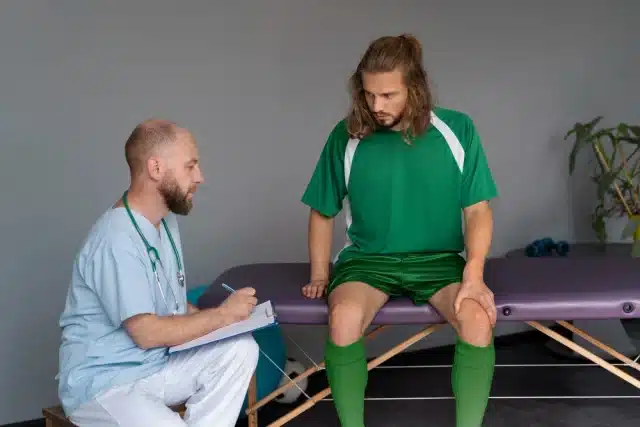Introduction
TMJ, or Temporomandibular Joint Disorder, is a condition that affects the joint connecting your jaw to your skull. This joint helps you chew, talk, and yawn. When it doesn’t work properly, it can cause pain, clicking sounds, and difficulty moving your jaw. Many people with TMJ experience jaw pain, headaches, and even earaches.
Physical therapy can be an effective way to treat TMJ problems. It focuses on improving the movement of your jaw, reducing pain, and helping you regain normal jaw function. Through simple exercises and special techniques, physical therapy can help ease the discomfort and prevent the condition from getting worse. It’s a non-invasive, natural way to manage TMJ and improve your quality of life.
What is TMJ Disorder (Temporomandibular Joint Dysfunction)?
TMJ disorder happens when there’s a problem with the temporomandibular joint, which connects your jaw to your skull. This joint works like a hinge, allowing your jaw to move up and down and side to side. When it doesn’t work properly, you may feel pain or discomfort in your jaw, face, or neck.
There are many causes of TMJ disorder. Some people get it from grinding or clenching their teeth, while others develop it after an injury to the jaw. Stress, arthritis, and even poor posture can also lead to TMJ problems. Common symptoms include jaw pain, stiffness, clicking or popping sounds when you move your jaw, and difficulty chewing or speaking.
TMJ disorder can affect anyone, but it’s more common in people who are stressed, anxious, or have a history of jaw injuries. Early treatment is important to stop the pain from getting worse.
How Physical Therapy Helps TMJ Disorder
Physical therapy is a popular treatment option for TMJ disorder because it focuses on improving how your jaw moves and reducing pain. A physical therapist can teach you special exercises that stretch and strengthen your jaw muscles. These exercises help improve mobility, reduce tension, and prevent the joint from becoming stiff or inflamed.
One of the main goals of physical therapy for TMJ is to relieve pressure on the joint. By doing gentle exercises and learning proper posture, you can reduce stress on your jaw and neck muscles, which helps alleviate pain. Physical therapists also use manual therapy, which involves massaging or gently moving the jaw to improve its function.
Physical therapy is a non-invasive treatment that doesn’t involve surgery or medication. It’s a safe and effective way to manage TMJ symptoms and improve your jaw’s ability to move without pain.
Common Physical Therapy Techniques for TMJ
Physical therapy for TMJ uses several techniques to improve jaw function and reduce discomfort. Some of the most common methods include:
- Jaw exercises: These exercises help increase the range of motion in your jaw, making it easier to open and close your mouth. A therapist may teach you how to gently move your jaw in different directions to keep the joint flexible.
- Stretching and strengthening: Targeted exercises stretch tight muscles and strengthen weak ones around your jaw and neck. This helps balance the muscles that control jaw movement.
- Manual therapy: A therapist may use hands-on techniques, such as massage or joint mobilization, to relax your jaw muscles and improve blood flow. This can relieve pain and help your jaw move more smoothly.
- Posture correction: Poor posture can put extra stress on your jaw and neck. Physical therapists can show you how to improve your posture to reduce strain on these areas.
These techniques work together to relieve pain, reduce inflammation, and improve how your jaw moves.
At-Home TMJ Exercises and Stretches
In addition to working with a physical therapist, you can do simple exercises at home to relieve TMJ pain. These exercises are easy to do and can help you feel better over time. Some common at-home exercises include:
- Relaxation techniques: Deep breathing and mindfulness exercises can help reduce stress, which often makes TMJ symptoms worse.
- Jaw stretches: Try gently opening and closing your mouth or moving your jaw from side to side. These stretches help keep your jaw muscles flexible.
- Tongue-up exercise: Place the tip of your tongue on the roof of your mouth and slowly open and close your mouth. This helps strengthen your jaw muscles without overworking them.
- Postural exercises: Sitting or standing with good posture can take pressure off your jaw. Practice keeping your head aligned with your spine and avoid slouching.
Doing these exercises regularly can help reduce tension in your jaw and improve its movement.
Additional Tips for Managing TMJ Pain
Aside from physical therapy and exercises, there are other ways to manage TMJ pain in your daily life. Here are some simple tips:
- Avoid hard or chewy foods: Stick to soft foods that are easier on your jaw. This can help prevent overworking your jaw muscles.
- Practice good posture: Keeping your neck and spine in alignment can reduce strain on your jaw muscles.
- Use heat or cold packs: Applying a warm compress or an ice pack to your jaw can help reduce pain and swelling.
- Manage stress: Stress can make TMJ symptoms worse, so try relaxation techniques like meditation, deep breathing, or yoga to keep your stress levels in check.
If your TMJ symptoms don’t improve or get worse, it may be time to see a specialist for more advanced treatment options.
When to See a Specialist for TMJ
If your TMJ pain doesn’t get better with physical therapy and home exercises, it’s important to see a specialist. A dentist, oral surgeon, or a physical therapist trained in TMJ disorders, like those at Austin Manual Therapy Associates, can offer more specific treatments. These might include custom mouthguards, medications, or, in rare cases, surgery.
Signs you should see a specialist include severe pain, trouble opening or closing your mouth, or if your symptoms last for a long time without improvement. A specialist can help you find the right treatment to get long-term relief.
Conclusion
Physical therapy is a safe and effective way to manage TMJ disorder. By practicing specific exercises, improving your posture, and following the advice of a physical therapist, you can reduce pain and improve jaw function. Consistent treatment can help prevent long-term damage and make everyday activities like talking and chewing easier. If you’re struggling with TMJ pain, don’t hesitate to seek help and start your journey toward relief.

Speaks from heart, always too passionate and driven by emotions. Spins the words with kindness & sharpness, intriguing your ever-inscrutable minds.




